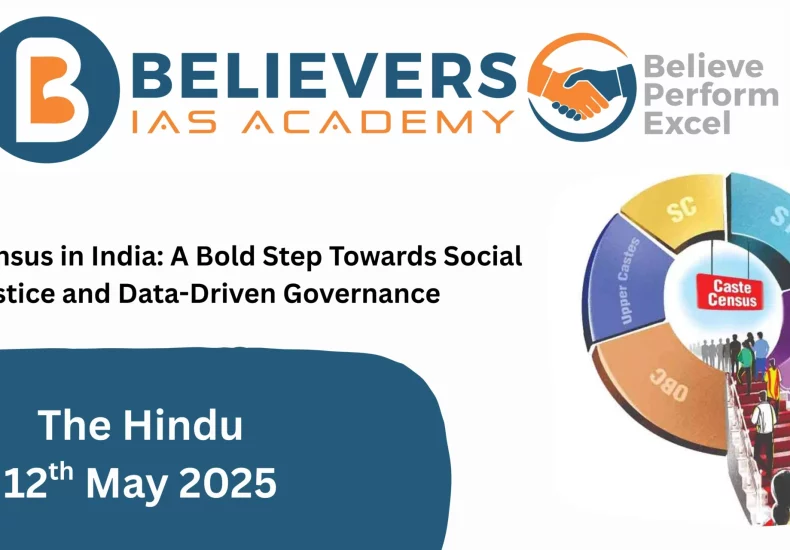Caste Census in India: A Daring Step In the direction of Social Justice and Knowledge-Pushed Governance
Context and Relevance
In a landmark transfer, the Narendra Modi authorities has introduced the inclusion of caste enumeration within the upcoming Census — a long-overdue step that would redefine the panorama of social justice policymaking in India. This choice is not only a political or administrative reform; it has far-reaching implications for governance, fairness, and constitutional mandates. For aspirants of the UPSC Civil Providers Examination, understanding the historic, authorized, social, and administrative dimensions of the caste census is crucial, particularly for subjects in GS Paper II (Governance, Structure, Polity) and GS Paper I (Indian Society).
Historic Background: From Colonial Counting to Submit-Independence Silence
-
The final full caste enumeration in India was performed in 1931 throughout British rule, which documented round 4,147 castes.
-
Submit-Independence, the Authorities of India continued enumerating solely Scheduled Castes (SCs) and Scheduled Tribes (STs) in each Census ranging from 1951.
-
The Different Backward Courses (OBCs), regardless of being constitutionally eligible for reservations, had been excluded from the Census course of, resulting in coverage planning in an proof vacuum.
-
Dr. B.R. Ambedkar, in his 1955 essay “Ideas on Linguistic States”, sharply criticized the omission of caste information within the 1951 Census as “petty intelligence” — underlining the necessity for visibility in information as a prerequisite for social justice.
Why Caste Census Issues At this time
1. Authorized and Constitutional Crucial
-
The Indian Structure, whereas talking of “social and academic backwardness”, makes use of the time period “courses” however, by means of judicial interpretation (e.g., Indra Sawhney vs. Union of India, 1992), caste has been accepted as a sound proxy for figuring out backwardness.
-
Reservations in schooling, public employment, and now native governance (through the 73rd and 74th Constitutional Amendments) for OBCs require granular, disaggregated caste information.
-
The 10% EWS quota for higher castes (2019) has additional elevated the necessity for an inclusive enumeration of all social teams.
2. Administrative Necessity
-
The Justice G. Rohini Fee (for sub-categorisation of OBCs) discovered that elite seize was rampant:
-
Simply 10 OBC castes took 25% of all advantages.
-
Round 75% of OBCs cornered 97% of the advantages.
-
38% of OBCs obtained solely 3%, whereas one other 37% obtained nothing.
-
-
With out information, creamy layer norms, profit monitoring, and rational sub-categorisation are unattainable.
3. Political and Social Relevance
-
Caste actions by communities just like the Marathas, Patidars, Jats, and Gujjars demanding reservations have typically been dealt with arbitrarily attributable to lack of exhausting information.
-
A caste census will enable governments to consider such claims transparently and empirically.
Classes from Previous Experiences
The SECC-2011 Debacle
The Bihar Success Mannequin (2023)
-
Used a vetted checklist of 214 castes, with a 215th choice for “Others”.
-
Deliberate, skilled, and digitally executed — demonstrating that correct caste enumeration will not be solely possible however replicable throughout India.
Blueprint for a Credible and Efficient Caste Census
To keep away from repeating previous errors, a profitable caste enumeration should embrace:
-
Authorized Mandate: Amend the Census Act, 1948 to explicitly embrace caste.
-
Institutional Readability: Entrust the duty solely to the Workplace of the Registrar Normal and Census Commissioner.
-
Standardised Questionnaire: Pre-coded drop-down choices for caste, sub-caste, aliases, surnames.
-
State-Particular Lists: Co-created with inputs from native communities, sociologists, and state governments.
-
Enumerator Coaching: On regional variations and terminology.
-
Use of Digital Instruments: Cell-based information assortment with in-built error checks.
-
Consultant Staffing: Deploy enumerators from numerous communities to minimise bias.
-
Oversight and Auditing: District-level supervisory committees for real-time monitoring.
-
Pilot Surveys: Check in numerous states earlier than nationwide implementation.
Conclusion:
A Knowledge-Pushed Future for Social Justice
The caste census will not be about selling id politics — it’s about acknowledging lived realities. By counting caste, India is taking a significant step towards evidence-based governance. The absence of information has allowed entrenched caste elites to monopolise assets whereas marginalised teams stay invisible.
The choice to incorporate caste enumeration within the upcoming Census is daring, transformative, and constitutionally important. It presents a novel alternative to right many years of omission and at last put in place a scientific, inclusive, and simply reservation and improvement coverage.
As UPSC aspirants and future policymakers, understanding and interesting with such reforms is not only educational — it’s foundational to shaping a greater India.


Leave a Reply